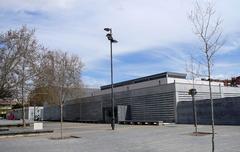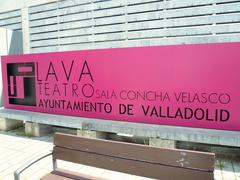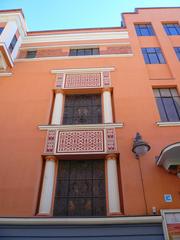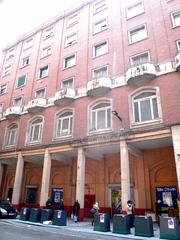
Renault Valladolid Factory: Visiting Hours, Tickets, and Tour Guide
Date: 03/07/2025
Introduction: A Hub of Innovation and Industrial Heritage
The Renault Valladolid Factory, located in the Castile and León region of Spain, stands as a remarkable symbol of automotive innovation, sustainability, and regional economic growth. Since its establishment in the early 1950s, the factory has transitioned from assembling vehicles with imported parts to being a cornerstone of Renault’s global manufacturing network, producing millions of engines and vehicles annually. Its commitment to digital transformation, environmental stewardship, and workforce development makes it a leading example of modern industrial operations.
This comprehensive guide provides detailed information on visiting hours, ticketing, guided tours, accessibility, and tips for making the most of your visit—including nearby cultural attractions. Whether you are passionate about automotive technology, Spain’s industrial history, or simply curious about how cars are made, the Renault Valladolid Factory promises an educational and engaging experience. For further resources, see (Renault Valladolid and Palencia), (Automotive Manufacturing Solutions), (Renault Group Valladolid Montaje Plant).
Table of Contents
- Historical Overview
- Visitor Information
- Socioeconomic Impact and Legacy
- Production, Innovation, and Sustainability Highlights
- Frequently Asked Questions (FAQ)
- Visuals and Media
- Internal and External Resources
- Conclusion and Visitor Recommendations
- Official Sources
Historical Overview
Early Foundations and Expansion
Construction of the Renault Valladolid Factory began in 1951, with production starting in 1953. The factory was initially established to serve Spain’s growing domestic market and as a gateway for exports to Europe (Renault Valladolid and Palencia). In its first decades, the plant assembled models such as the Renault 4CV and the iconic Renault 4, quickly expanding capacity and workforce through the 1960s and 1970s (Renault Valladolid factory).
Technological Modernization
The 1980s and 1990s marked significant advancements, with the introduction of automation, robotics, and advanced quality controls. The plant diversified its production to include models like the Renault 5, Clio, and Megane, and pioneered environmentally friendly manufacturing processes.
Integration With Renault-Nissan Alliance
From the 2000s onward, Valladolid became integral to the Renault-Nissan Alliance, producing engines and vehicles for multiple brands and supporting global supply chains.
Current Role and Developments
As of 2025, the factory is a model of Industry 4.0, embracing digitalization, data-driven manufacturing, and electric mobility. It produces popular models such as the Renault Captur and the Symbioz hybrid SUV, as well as engines for Renault, Nissan, and other partner brands. Valladolid is also pioneering production of hydrogen and e-fuel-compatible engines for the future (Automotive Manufacturing Solutions, Diario de Valladolid).
Visitor Information
Visiting Hours and Tickets
- Standard Hours: Monday to Friday, 9:00 AM to 5:00 PM. Some tours may be available on Saturdays by appointment or during special events.
- Ticketing: All visits require advance booking; there are no walk-in options. Ticket prices and discounts vary by group size and type (e.g., student, senior, professional, school group). Check the official Renault Group Valladolid Montaje Plant page for up-to-date info.
Guided Tours and Special Events
Guided tours offer a close-up look at manufacturing lines, including the sheet metal workshop, high-tech painting facilities, battery assembly, and environmental initiatives. Tours last approximately 90 minutes to two hours and are available in Spanish, English, and German (by request). Special open days and exhibitions may be announced throughout the year.
Accessibility
The entire visitor route is wheelchair accessible, with facilities available for people with limited mobility. Please indicate any special needs when booking.
Booking Procedures
- How to Book: Contact Renault España or an authorized partner by phone (+34 983 41 60 00), email, or via the official website. Specify date, group size, and language preference.
- ID and Security: All visitors must bring valid photo ID for security clearance. PPE (such as vests and safety glasses) is provided.
- Photography: Allowed only in designated zones; ask your guide for specifics.
Arrival and Security
Arrive at the main security gate for check-in. Safety briefings and protective equipment are mandatory.
Travel Tips and Nearby Attractions
- Getting There: The factory is located on Avenida Ramón Pradera, Valladolid, accessible by car, taxi, or public transport from the city center (about a 15-minute drive).
- Parking: Available on-site.
- Dress Code: Wear comfortable, closed-toe shoes and avoid loose clothing.
- Local Sights: Combine your visit with the Valladolid Cathedral, National Sculpture Museum, Campo Grande park, and local gastronomy (My Free Range Family).
Socioeconomic Impact and Legacy
The Renault Valladolid Factory is a major driver of economic growth in Castilla y León, supporting over 100,000 jobs (direct and indirect) and collaborating with more than 150 suppliers. It is recognized as a Priority Industrial Project by the regional government, ensuring continued investment and innovation (Automotive Skills Alliance, El Economista).
Production, Innovation, and Sustainability Highlights
- Annual Output: Over 1.5 million engines and 250,000 vehicles as of 2024.
- Digital Transformation: Industry 4.0 initiatives include Wi-Fi-enabled machinery, digital twins, and smart data analytics, resulting in improved efficiency and quality (Automotive Manufacturing Solutions).
- Sustainability: On-site solar panels, water and energy reduction programs, and a shift to hybrid and alternative powertrains.
- Education & R&D: Partnership with universities for talent development and an on-site R&D center focused on future mobility (Horse Powertrain).
Frequently Asked Questions (FAQ)
Q: What are the Renault Valladolid Factory visiting hours?
A: Monday to Friday, 9:00 AM–5:00 PM (advance booking required).
Q: How do I book a tour?
A: Via the official website or by contacting Renault España; all visits require pre-approval.
Q: Are tours available in languages other than Spanish?
A: Yes, English and German tours are available by request.
Q: Is the factory accessible for people with disabilities?
A: Yes, the tour route and facilities are accessible.
Q: Can I take photos during the tour?
A: Only in designated areas; check with your guide.
Q: Are children allowed?
A: Yes, but age restrictions may apply; check when booking.
Visuals and Media
Suggested images for your visit or publication include:
- “Renault Valladolid Factory robotic assembly line tour”
- “Guided tour at Renault Valladolid Factory battery assembly”
- “Renault Valladolid Factory main entrance for visitors”
- “Solar panels at Renault Valladolid Factory roof”
Virtual tours and high-resolution images are available on the official Renault Group website.
Internal and External Resources
For further exploration:
- Renault Valladolid and Palencia
- Automotive Manufacturing Solutions: Spain’s Rising Star
- Horse Powertrain Valladolid
- Official Renault Valladolid Visitor Information
- Visit Valladolid – Tourism Guide
- My Free Range Family – Things to Do in Valladolid
Conclusion and Visitor Recommendations
The Renault Valladolid Factory is a living testament to Spain’s industrial evolution and a beacon of automotive innovation. Visitors enjoy a rare window into high-tech manufacturing, digital transformation, and sustainable practices. The factory’s central location and accessibility make it an essential stop for anyone interested in industry or local culture. Advance booking is essential; plan ahead and combine your visit with Valladolid’s many historic attractions.
For updates, download the Audiala app and follow Renault Valladolid on social media. Engage with related content to deepen your knowledge of Spain’s automotive sector and future trends.
Official Sources and Further Reading
- Renault Valladolid and Palencia, 2019, ResearchGate
- Spain’s Rising Star, 2024, Automotive Manufacturing Solutions
- Horse accelerates digital twin integration at Valladolid, 2024, Automotive Manufacturing Solutions
- Planta Horse Valladolid fabricará motores de hidrógeno para Renault, 2023, Diario de Valladolid
- Castilla y León a strategic hub for the Spanish automotive sector, 2024, Automotive Skills Alliance
- El plan industrial de Renault para Valladolid y Palencia, 2024, El Economista
- Renault Group Valladolid Montaje Plant, 2025, Renault Group





